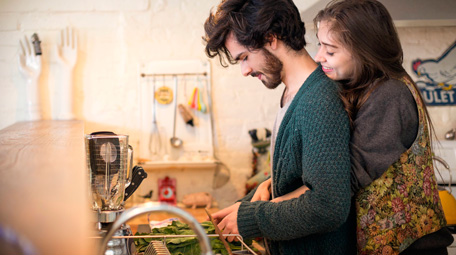
Millennials are bringing their I-want-to-do attitudes and their mobile devices into the kitchen. They’re turning to mobile at every phase of the cooking journey—deciding what to make, learning how to prepare it, and actually cooking or baking—and smart brands are there to help in each micro-moment.
Millennials asks lots of questions in the kitchen, but maybe none more frequently than: “Where do I put my phone so I don’t spill on it?”
Through research with mcgarrybowen and Kraft Foods, we found that, while people over 35 are more likely to print out a recipe,1 59% of 25- to 34-year-olds cook with either their smartphones or tablets handy.2
The smartphone is becoming the ultimate sous-chef for millennials who are taking an I-want-to-do attitude into the kitchen. Our research indicates that online 25- to 34-year-olds (how we’re defining millennials here) prefer the culinary process as much as the finished dish: They want to dive into everything, experiment with new recipes, and learn new skills.3
“We see through secondary research that millennials are cooking more,” says Anna Conroy, planning director for mcgarrybowen. “It isn’t a chore as much as an ability to create an experience.”
In many micro-moments, they’re turning to mobile to get all the information and guidance they need. We’ve boiled this fragmented consumer journey down to three major phases—from that initial spark to preparation to the actual cooking. And we’ll serve up some key takeaways for brands that want to reach millennials at the important moments leading up to mealtime.
59% of 25- to 34-year-olds head to the kitchen with either their smartphones or tablets.
The spark phase
The cooking journey starts with a spark—a curiosity about what to cook. These what-do-I-make moments can be confusing to millennials, with 31% of them saying that choosing what to cook was the least enjoyable part of the cooking process.3
Related Story
Millennials Eat Up YouTube Food Videos
Learn how YouTube is fueling the foodie fan culture.
They turn to search for help, and the top 100 food search terms tend to be broad in nature (“dinner ideas,” “healthy recipes,” and “slow cooker recipes,” for example).4 Search interest for “best recipes” on YouTube is up 48% year over year.5

While nearly one-third of millennials say they don’t enjoy choosing what to cook, it certainly doesn’t deter them from being creative. Our research shows that, for a quarter of online millennials, the most important part of cooking is adding a personal touch to make a recipe unique.6 Take food hacks, kitchen tricks that make cooking easier and more fun, for instance. Forty-one percent of the millennials we surveyed are interested in them.6 Popular examples range from coffee hacks to Oreo hacks6. YouTube creator CrazyRussianHacker is a master of the food hack genre. His “Food Life Hacks” playlist—where he teaches his fans how to do everything from cook eggs in the microwave to awesome ways to cut a watermelon—has more than 545K views (at the time of writing).
For brands: Tap into millennials’ curiosity—and their broad recipe searches—with specific cooking ideas. Perhaps a hackable salmon recipe in response to a “healthy recipes” search. Turn the stressful experience of deciding what to make for dinner into a fun exploration.
Source: https://www.thinkwithgoogle.com/articles/cooking-trends-among-millennials.html









